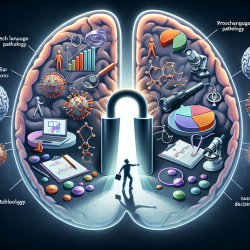Introduction
The use of the human voice as a biomarker for health conditions is a burgeoning field, particularly in pediatrics. The recent scoping review, "Voice as a Biomarker of Pediatric Health: A Scoping Review," highlights the potential of using voice analysis, coupled with artificial intelligence (AI), to detect and monitor various pediatric conditions. This blog post will explore how practitioners can enhance their skills by integrating these findings into their practice and encourage further research in this promising area.
Understanding the Potential of Vocal Biomarkers
The review analyzed 62 studies, focusing on the use of AI to evaluate pediatric voice recordings. The studies highlighted the potential of vocal biomarkers in diagnosing developmental, respiratory, and speech-language conditions. Autism spectrum disorder, intellectual disabilities, asphyxia, and asthma were among the most frequently studied conditions.
Mel-Frequency Cepstral Coefficients (MFCCs) emerged as the most utilized feature extraction method, while Support Vector Machines (SVM) were the predominant AI model. The combination of these techniques demonstrated high diagnostic accuracy, making them valuable tools for practitioners.
Practical Applications for Practitioners
Practitioners can leverage these insights in several ways:
- Early Detection and Diagnosis: By incorporating AI-based voice analysis into routine assessments, practitioners can potentially identify conditions such as autism spectrum disorder or asthma earlier, allowing for timely interventions.
- Non-Invasive Monitoring: Voice analysis offers a non-invasive, cost-effective method for ongoing monitoring of pediatric conditions, reducing the need for more intrusive procedures.
- Customized Interventions: Understanding the vocal biomarkers associated with specific conditions can help tailor interventions to meet individual needs, improving outcomes for children.
Encouraging Further Research
While the current research is promising, further studies are needed to standardize feature extraction methods and AI models. Practitioners can contribute to this research by:
- Participating in Research Studies: Collaborating with researchers to provide data and insights from clinical practice can help refine AI models and improve their applicability.
- Exploring New Applications: Investigating the use of vocal biomarkers for conditions not yet covered in existing studies can expand the potential applications of this technology.
- Advocating for Standardization: Supporting efforts to standardize methods across studies will enhance the reliability and comparability of research findings.
Conclusion
The integration of AI and voice analysis in pediatric health holds significant promise for improving the early detection, diagnosis, and management of various conditions. By embracing these advancements, practitioners can enhance their practice and contribute to the ongoing development of this innovative field.
To read the original research paper, please follow this link: Voice as a Biomarker of Pediatric Health: A Scoping Review.










